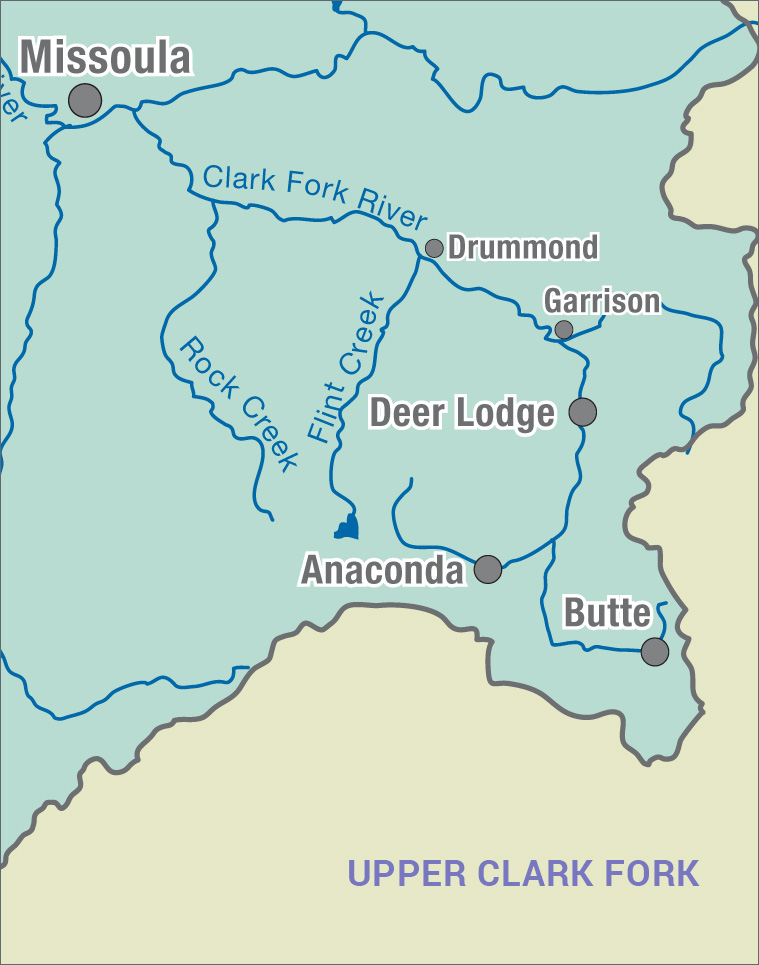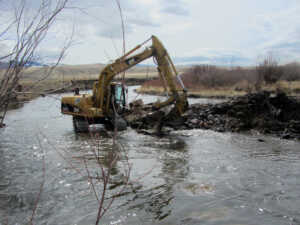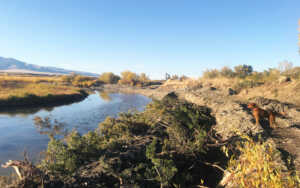Upper Clark Fork Diversion Dam Removal Project
March 14, 2022

Above: Alvi-Beck site in October 2021 after installation of rock riffle diversion and fish screen. Volunteers planted new willows and shrubs to help the site recover.
A River in Transition
By Andy Fischer (Clark Fork Coalition) and Casey Hackathorn (Trout Unlimited)
With 43 miles of Superfund cleanup underway at its headwaters, the Upper Clark Fork is a river in transition. A multi-decade effort is working to rid the Clark Fork floodplain of contamination from historical upstream mining activities. In addition, Clark Fork Coalition and Trout Unlimited have partnered to ensure that the river is also freed from the impacts of aging irrigation diversion dams.

River-wide irrigation dams are still common sights in the Upper Clark Fork River. While these dams function to move needed irrigation water into ditches, these formidable structures also block passage for fish and recreationists. Fortunately, better designs that meet the needs of fish and irrigators alike are available. That’s why, in 2018, we began the multi-year Upper Clark Fork Diversion Dam Removal project.
Our goal is to fully reconnect 28 miles of mainstem river and 170 miles of tributary habitat by upgrading eight irrigation dams upstream of Deer Lodge. More than 150 years of intensive mining and agricultural use heavily impacted the reach where these dams are located. In addition to contaminating the floodplain with mine waste, industrial use created a vast system of irrigation dams and ditches that continue to impact our fisheries and create hazards to river recreation. Following a 2017 investigation of project opportunities, Clark Fork Coalition, Trout Unlimited, and the Montana Natural Resource Damage Program prioritized eight diversions.
Landowners: The Key to Success
While our relationship with landowners is always central to our work, landowner collaboration is especially key to the success of these projects. All eight dam sites are owned and operated by private landowners. They depend upon these structures to support the critical function of delivering water to their fields.

Traditionally, many of these rock and earth dams are reconstructed annually using heavy equipment in the river and on its banks. This practice can potentially damage the river bed, as well as bank soils and vegetation, and increase erosion of sediment into the river. The improvements proposed at these sites are designed to meet agricultural needs while also benefiting fish and recreation. We are also working to craft solutions that help modernize infrastructure and lower maintenance costs.
To date, we have completed two of the diversion removals thanks to a grant from the Open Rivers Fund, a program of Resources Legacy Fund supported by the William and Flora Hewlett Foundation, and other partners. So far, we have opened up 29 miles of mainstem and tributary habitat for people and fish. The short film below shows the Alvi-Beck project at Dry Cottonwood Creek Ranch (which CFC sold in 2021) as an example of how we work together to improve the river.

Unique Solutions
At Alvi-Beck, we used a rock riffle diversion coupled with a corrugated water screen. This structure ensures water is delivered to fields with virtually no negative impact on fish or recreation. As a result, fish that attempt to enter the ditch are now moved across a screen instead, then safely returned to the river.

Throughout the process of constructing the Alvi-Beck diversion and screen we learned a great deal. As we turn to the remaining six targeted diversions, we hope this first project will serve as a demonstration of a functioning, low-impact diversion and fish screen for other landowners. We believe in inclusion of all parties in problem-solving and recognize the fact that livelihoods are tied to water use. Each aging dam that is removed will require unique solutions.
Learn more about this project in our Summer 2020 Riffles and stay tuned for further updates as this effort progresses!
